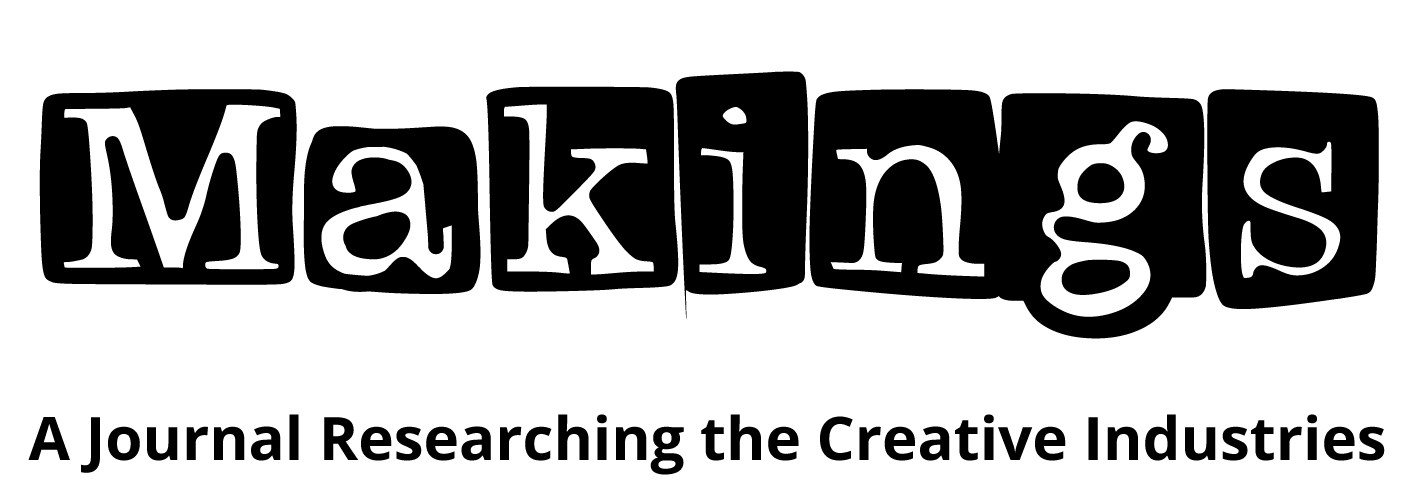Contributor Guidelines
Makings journal welcomes pieces from all disciplines which focus on the creative and cultural industries. Each issue centres on a particular theme, but responses can vary dependent upon the contributor’s interest and experience. Proposals for the Studio section are accepted on a rolling basis, and they do not necessarily have to address the current theme. All proposed contributions will be considered by the whole editorial panel. All articles will go through a double-blind peer review prior to publication.
Please note that Makings journal shall be entitled to the first use of the contribution for the online platform, but the author remains the copyright owner and can republish their contribution without seeking the journal’s permission. Makings reserves the right to decline to publish contributions if they are submitted after the agreed deadline and without the editors being informed (and agreeing to) a new submission date.
Abstracts
Please submit an abstract of up to 300 words to the editors. Links to external websites and the use of images, audio and video clips are also welcome. Once abstract submissions have been reviewed, contributors will be contacted with the outcome of the submission and, if applicable, the deadline for the final piece.
With your abstract, please include a short bio, up to 150 words, including your name, institutional affiliation (if appropriate), email address, current research stage, and other useful/interesting information. Please note that the bio and contact email address will be published alongside your contribution.
Articles
Publication format: All articles will be published online, with a PDF version available for download.
Word limit: Up to 6,000 (excluding references, footnotes, endnotes, and abstract). Please do not submit full dissertations or theses.
Structure: There is no strict requirement for the structure, though we expect each article to have an introduction, a conclusion, and an indication of the approach to the methodology used.
Style guidelines:
- For direct quotes, please use “double” quotation marks.
- Any direct quotes must be referenced using Harvard referencing, including the publication year and page number. For example: Markussen’s definition of the ecology of culture captures this symbiosis: “the complex interdependencies that shape the demand for and production of arts and cultural offerings” (2011, p. 10).
- Footnotes or endnotes can be used, as can direct hyperlinks to online content. Please note that all footnotes will be converted to endnotes for the webpage version but will remain as footnotes for the PDF version.
Please take a look at our latest publications for examples of the style but if you have any questions, please do not hesitate to get in touch with the editors.
References: If you refer to other publications within your piece, list these in the References section at the end. Please use Harvard referencing.
File format: Please email submissions as attachments to the editors. All articles should be provided as a .doc or .docx file. Please make sure to anonymise your submission as it will be undergoing a double-blind peer review.
Accompanying media: With every article, we encourage you to submit a featured image that you would like to appear alongside your article (please see our previous publications for examples). All images and web-ready audio or video clips should be emailed as separate files, or through a file-sharing platform such as WeTransfer, Dropbox, or Google Drive. Please make sure that every image, audio, or video accompanying your article has a caption.
Contributions to Studio
Contributions to the Studio section do not have any strict guidelines, so please get in touch with the editors with any specific questions or ideas you may have about the format. Here are the guidelines for the most common formats:
Video and audio contributions: As a rule, any videos or audio contributions accepted for publication will be uploaded to the journal’s YouTube channel, and the link will be made available on the journal’s website, along with any accompanying text or commentary.
Blog posts: A blog post should be up to 1000 words. It is an opportunity to test an idea, concept or style of presenting. Your blog post might an example of good practice you wish to share with your peers and a wider readership. As a test for academic writing, this could be a space for beginning to think about how you might contextualise your ideas or develop the concepts into academic research. Unlike an academic article, the peer review process will be light-touch and with the aim of ensuring clarity for the readers. There is no set structure but this is a guideline for writing an academic blog post:
- Start by introducing your subject/idea.
- Organise your points so that the most important ideas come earlier, to ensure they catch the reader’s attention.
- Choose a short catchy title (less than 140 characters).
- Use tables, links, images, a video if appropriate.
- If you are working from a longer article, think of translating your work into a concise form, prioritising key points rather than a methodology or the broader context.
- Short paragraphs, bullet points and headings can break the text up to help keep the reader engaged.
- Be careful with acronyms.
- End the blog in a way that sums up or encapsulates your key points and perhaps suggestions for future developments.
Some examples of academic blogs:
- Patter by Pat Thomson
- The Thesis Whisperer by Professor Inger Mewburn
- The Conversation is a collaboration between universities
